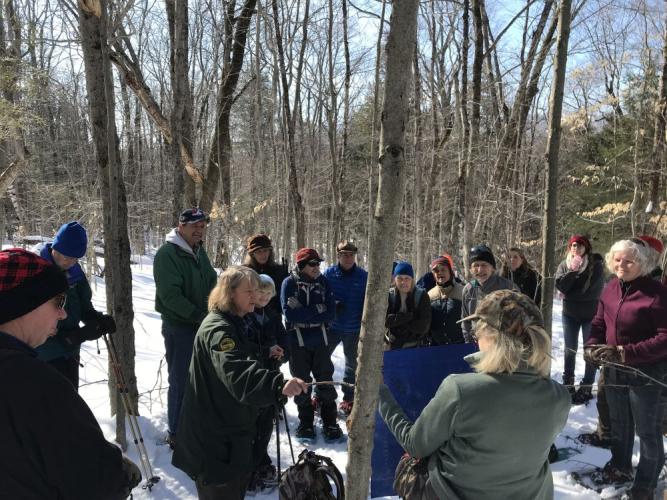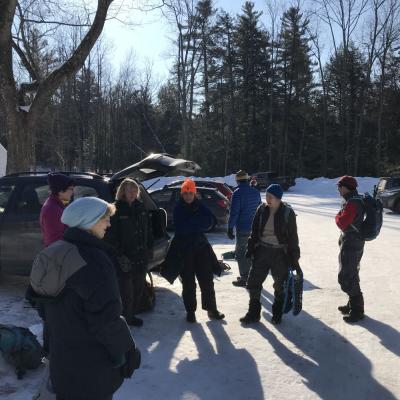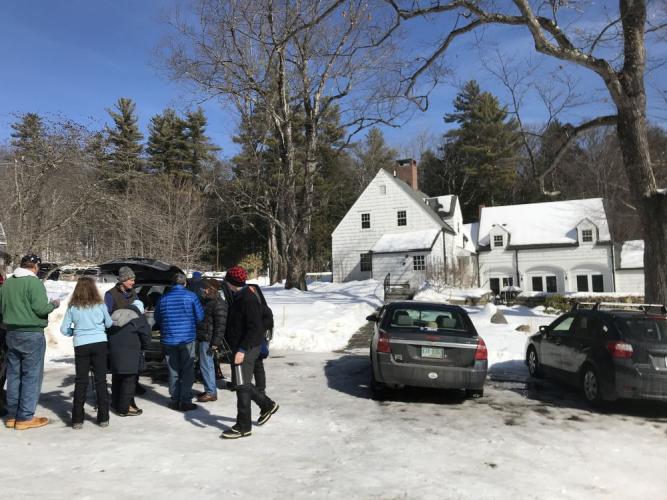Renowned wildlife tracking expert Sue Morse leads snowshoe tour

Sue Morse leads a recent wild mammal tracking workshop at the Forest Society's Hay Forest Reservation and The Fells Historic Estate and Gardens in Newbury.
A perfectly clear, 'bluebird day" greeted particpants arriving to hike with Sue Morse of Keeping Track at The Fells in mid-February.
This winter mammal tracking class and tour departed from the gatehouse parking lot at The Fells and proceeded across the road onto the Forest Society 700+-acre Hay Forest Reservation in Newbury.
Twenty students of mammal tracking filed into the forest to hike for nearly a mile on snowshoes over 3 hours while enthralled by Sue Morse's interpretation of tracks and other signs of winter wildlife travels.

Ample snow following a week of colder temperatures and with a few nights of accumulated tracks following a recent storm provided decent snow conditions for following tracks and identifying wildlife present.
These various tracks, scats, scent mark posts and signs of browsing herbivores included evidence of resident coyotes, chipmunks, ermines, gray squirrels, snowshoe hares, fishers, white-footed mice and more.

The group did not encounter fresh deer tracks or scat but did find a buck deer territorial antler rub from the November rut. Sue discussed deer breeding, biology and territorial scent marking.
Nor did we encounter any recent, fresh signs of moose tracks. But we did find former moose browse marks on red maple and striped maple stems.

The tiny paired prints of ermine tracks predictably occured along a stonewall where the small weasel entered and exited crevices and holes in the snow to access the subnivian — literally "below the snow" spaces — where smaller weasels hunt for small rodents — white footed mice, deer mice, voles and shrews.
A set of porcupine tracks led to a large hollow tree — an active porcupine den site with a resident porcupine audibly scratching inside the snag. Sue plunged a ski pole into the snow to spear dung and talked about the scent of porcupine dung scattered around the entrance to the den almost like a wine sommelier: "a heady mix of vegetation with a strong finish note of paraffin wax." The ensuing discussion included the September mating rituals and vocalizations of breeding porcupines. With a few predictable jokes about how breeding is a "prickly business" for porcupines. And how porcupine natural predators in New England are limited to fishers.

Speaking of fishers — a species of particular interest to most people based on their ferocious and often exaggerated reputation for vocalization and for preying on house cats — we followed at least one fisher track which included territorial scent marking on sticks or stumps protruding above the snow. Soft rotting small diameter stumps are a common forest floor feature Sue affectionately refers to as "pokey-uppies." Soft stumps left above the snow absorb the scent exretions from anal musk glands that give the weasels their family name "Mustelidae" — "Mustelids" are the weasel family members. Scent marking allows normally solitary fishers to locate or potentially to attract mates during their late February breeding season. Delayed implantation of the resulting fertilized embryo takes place in late autumn. Young fishers are born in late April or early May in a hollow tree den. The birth takes place well after females have bred a subsequent time so the female fishers are essentially always pregnant.
A stand of large mature hemlocks provided the opportunity for Sue to spot signs of adult bear useage and indications that the large diameter trees with extensive scaffold of branches had been used by a sow black bear as a "nursery tree" where cubs had climbed to relative safety during the summer cub-rearing season.
Sue's experience with black bear bite marks and claw marks allowed her to spot the scratches in the bark where bears had climbed these large, old hemlocks. Sue described the matriarchal society of female black bears and research suggesting how different individual male "boars" may enter a female territory in June in courtship and how important territorial scent marking is as bears can recognize one another from scent marks left on communal scent marking trees — often red pines with craggy aromatic bark and pitch deposits that trap scent and collect black bear fur.

Fells Education Director Brick Moltz smiled while marveling at how Sue seemed to know just where to look and where to find specific wildlife features without advance scouting. The key has been anticipating where wildlife movements and corridors tend to occur — along rivers, edges of wetlands, ridgelines and where topography or terrain tend to funnel travel into pinch points in the landscape. These critical wildlife travel corridors link larger blocks of contiguous habitats including unfragmented blocks of forest to form a habitat matrix even within more developed areas of roads, homes, businesses and farms.
The experience of hiking on snowshoes on the Forest Society's Hay Forest Reservation with Sue Morse provided an extraordinary opportunity to learn and share information about winter mammals — their tracks, preferred habitats, breeding behaviors, scent marking, feeding and more.
Sue Morse is also an ardent conservationist advocating that her many students continue tracking and share the information learned with landowners and land managers involved in making land use decisions. As Sue often says while raising her hand — "Repeat after me... " and then dispenses an adage with the wisdom of decades spent photographing and teaching about wild mammals — "Half of all tracking is knowing where to look and the other half? The other half is looking!"
Upon returning to the Gate House at The Fells Historic Estate and Gardens, we shared smiles and handshakes and a renewed enthusiasm for following tracks in the snow.

